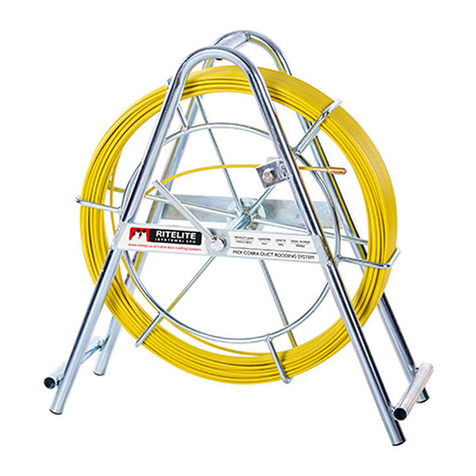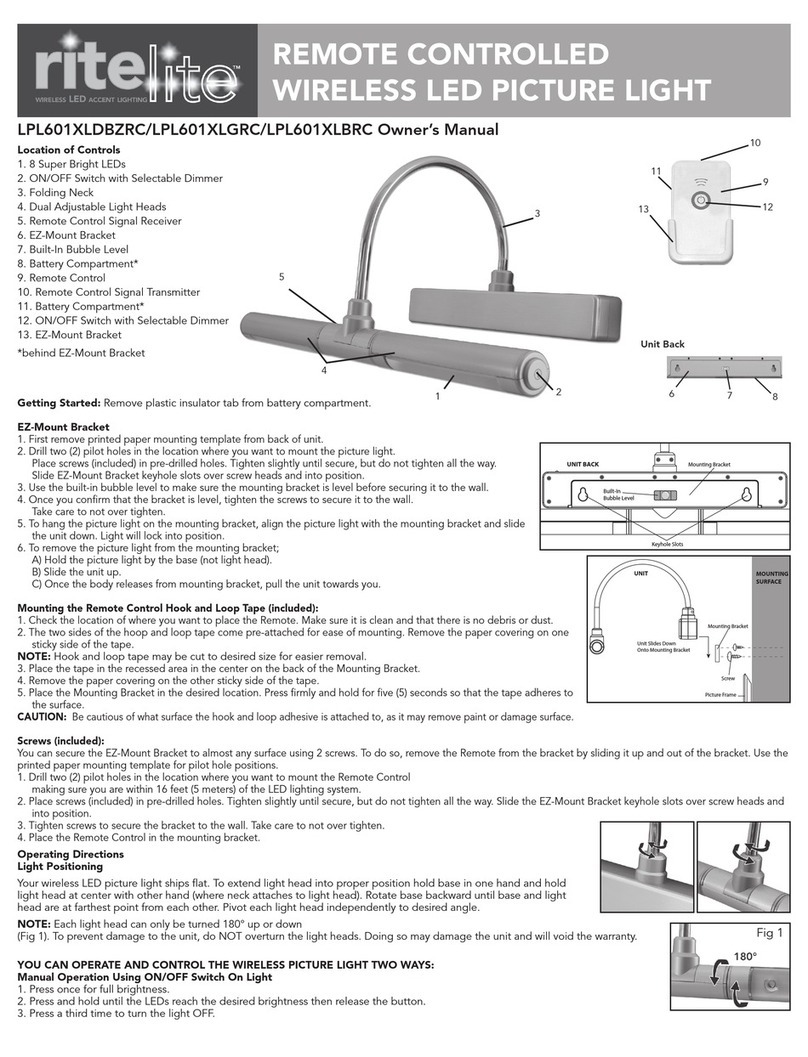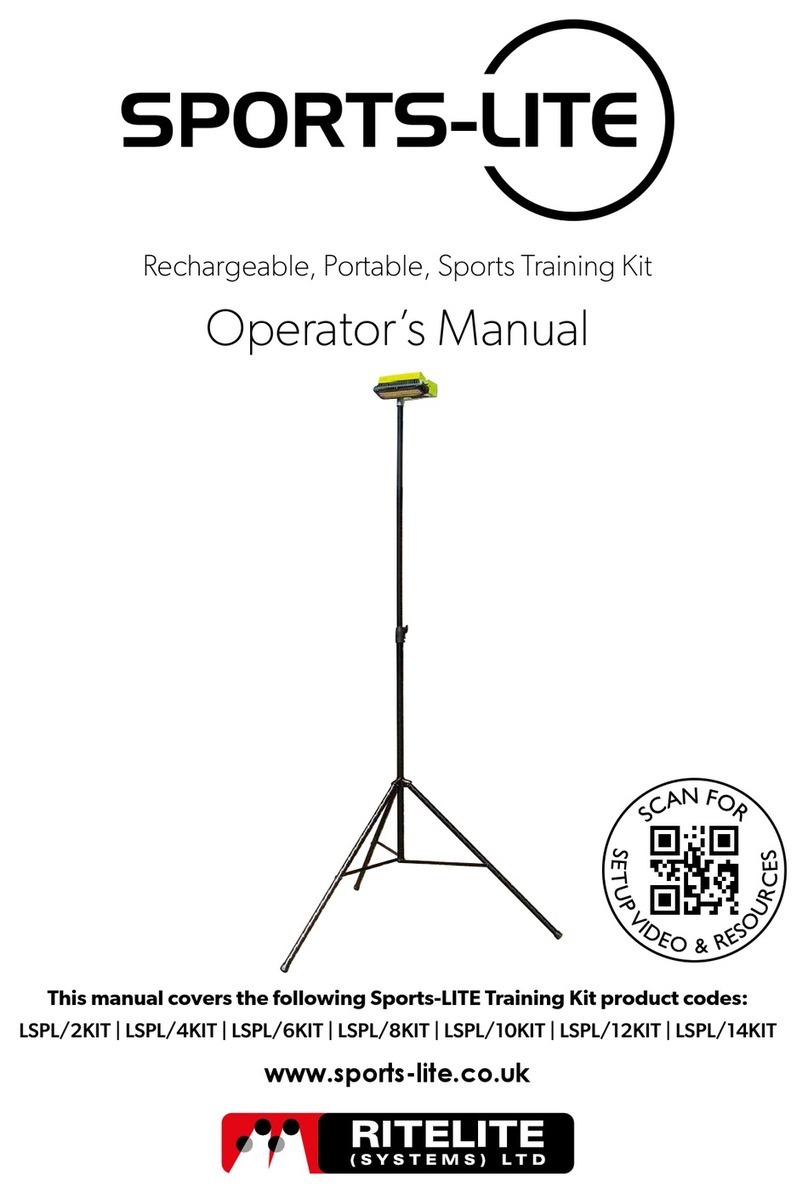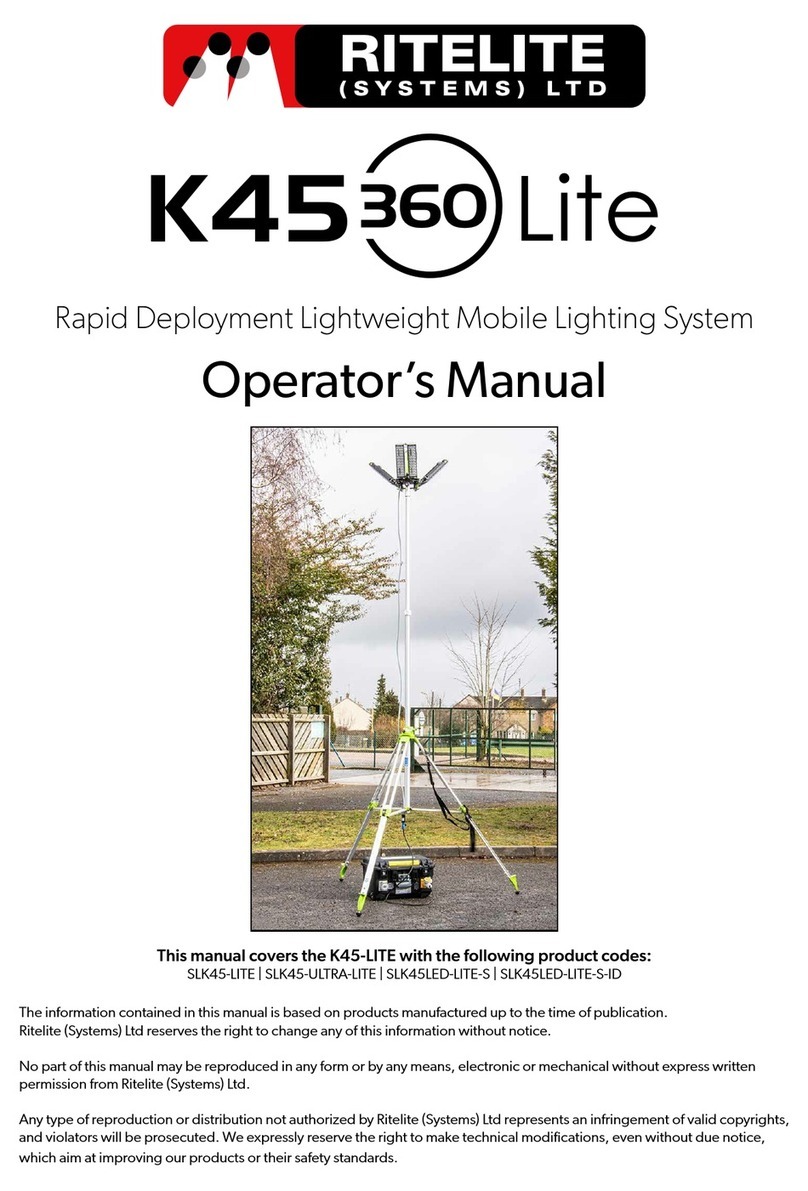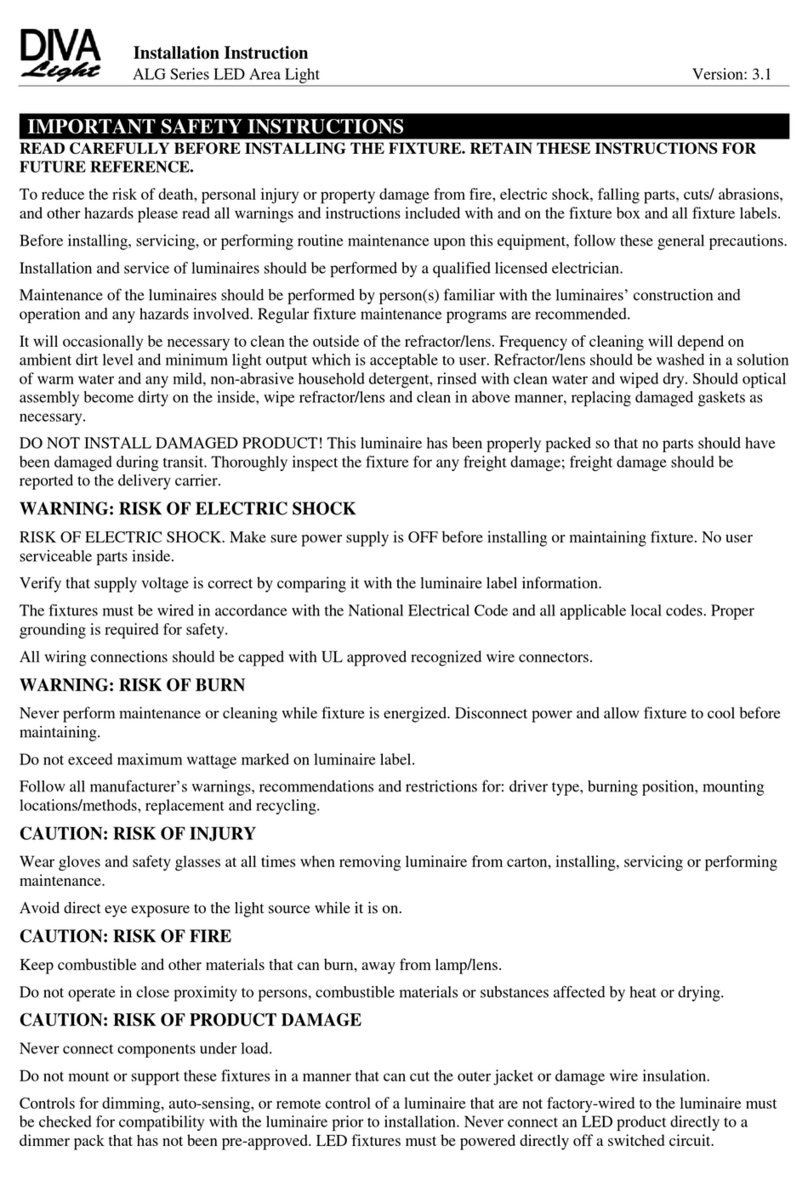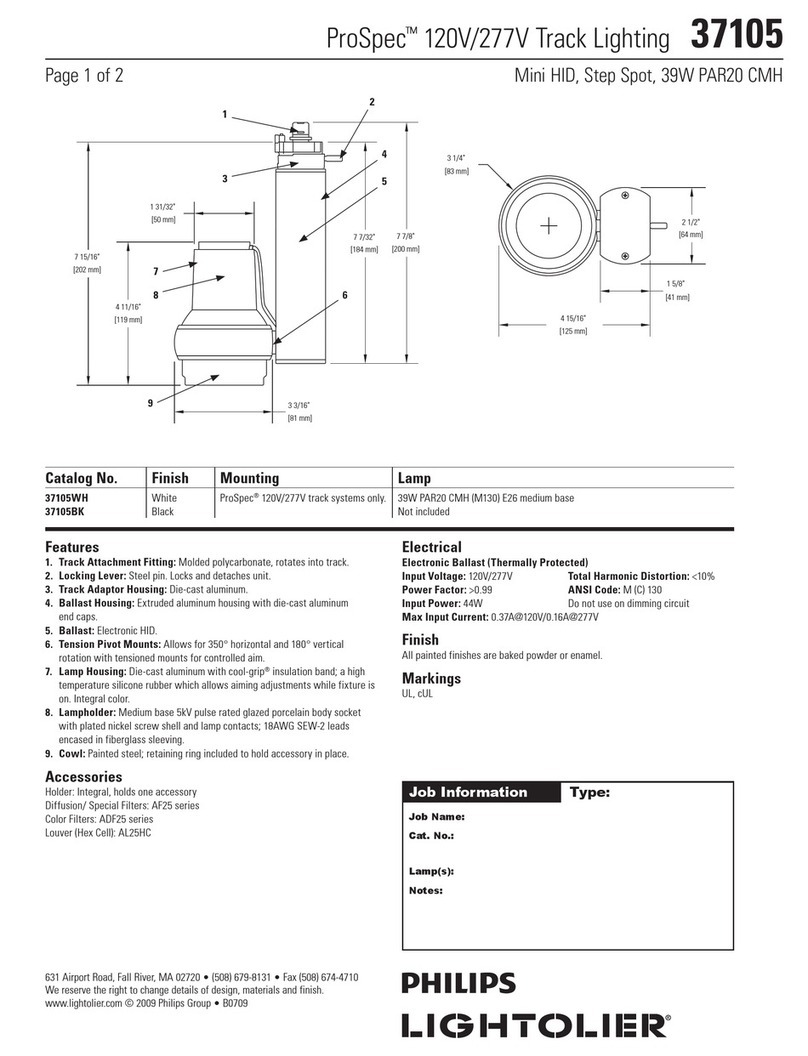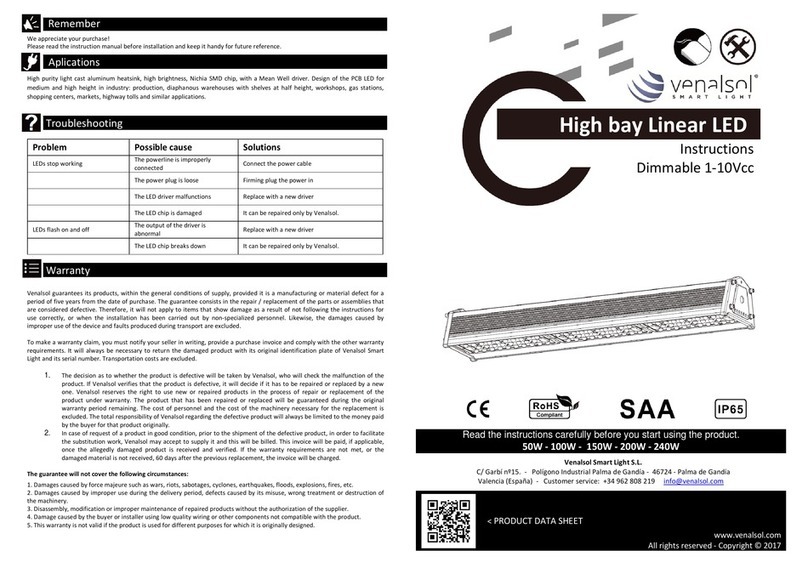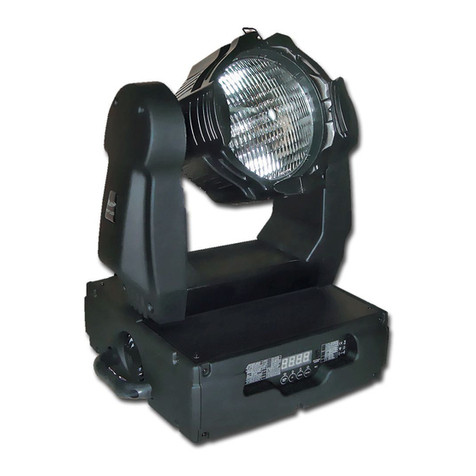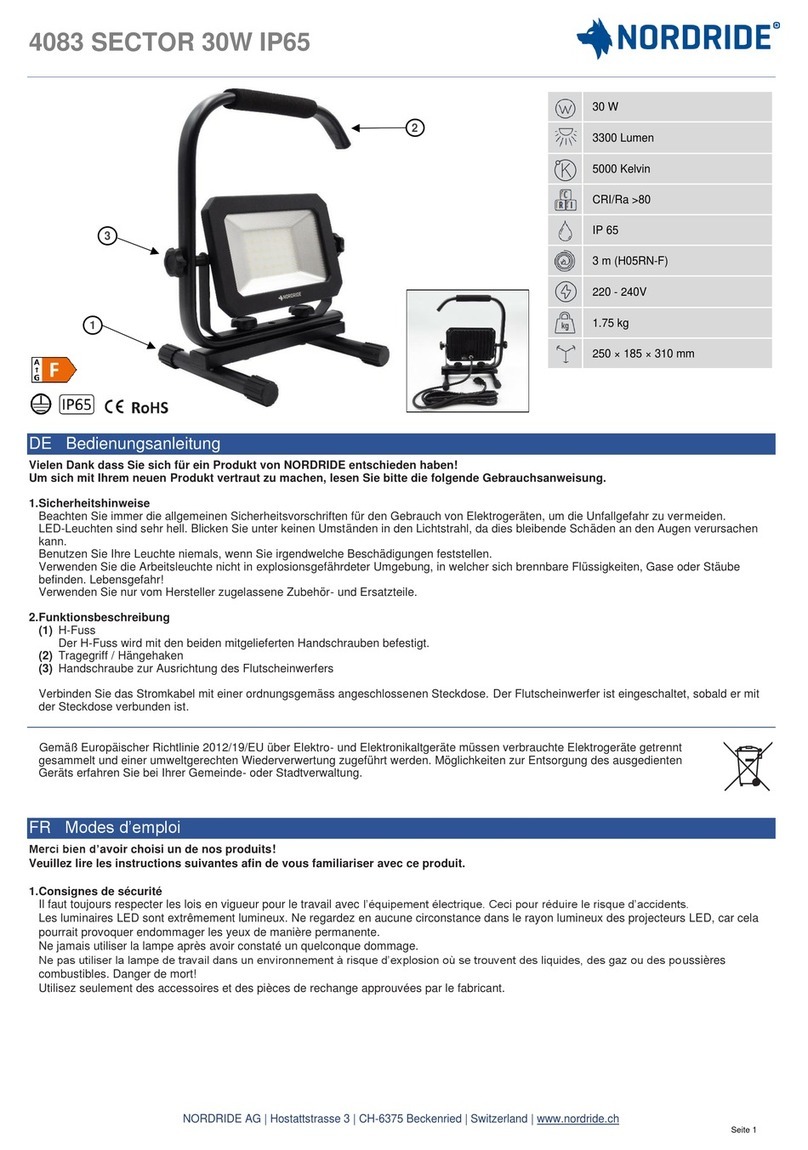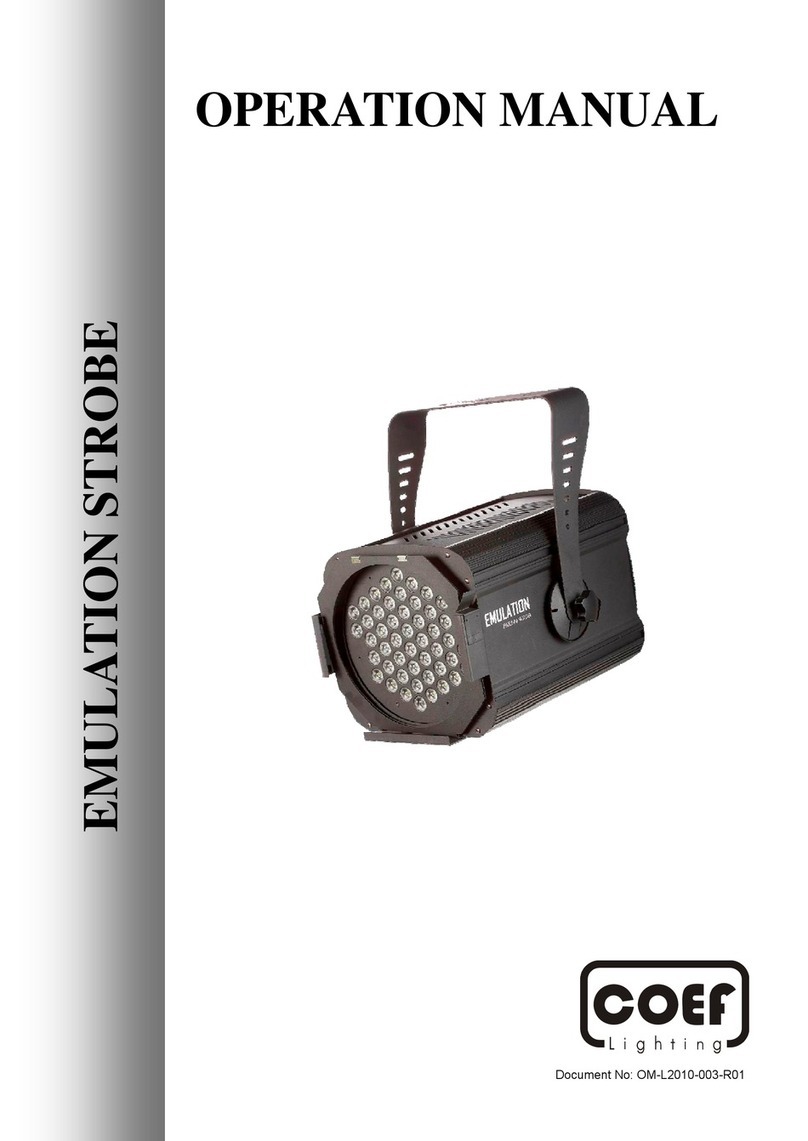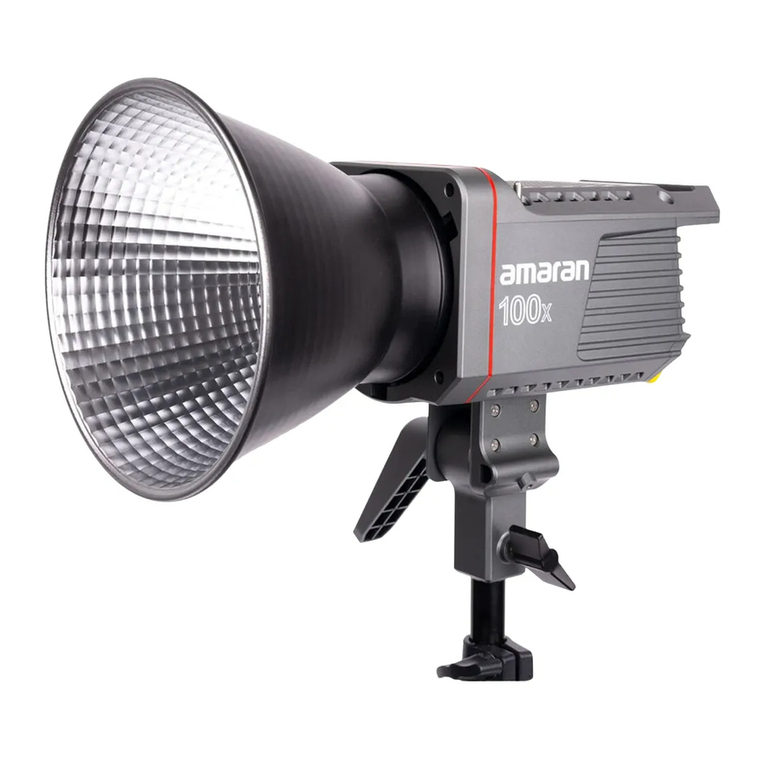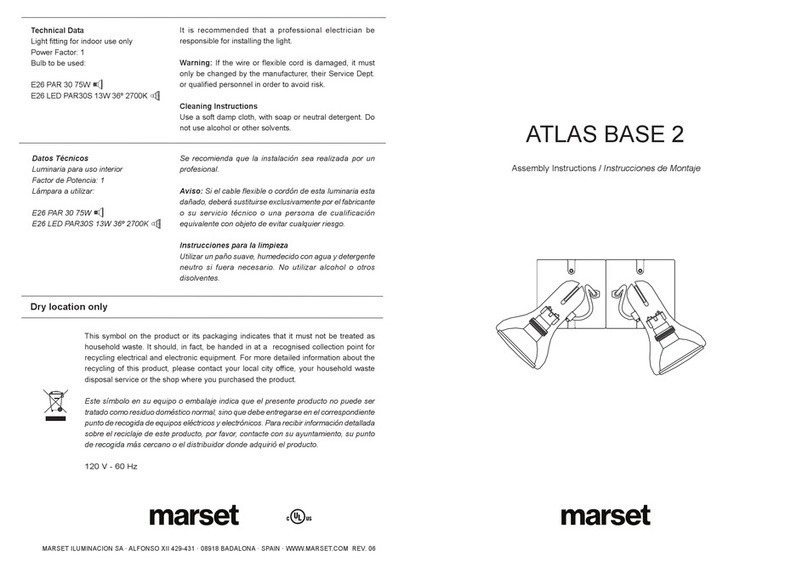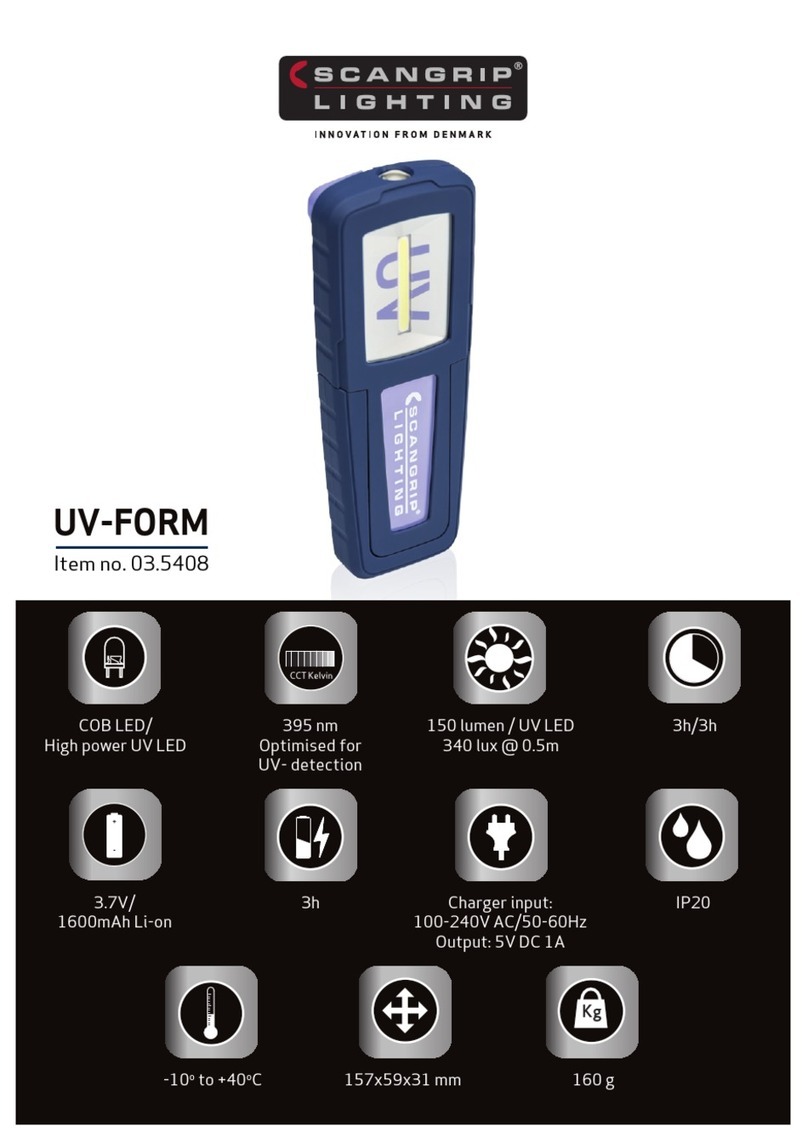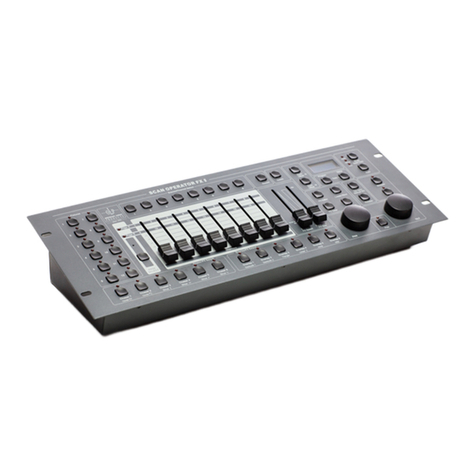Ritelite Quad Pod K50 User manual

Quad Pod K50 / K65
Rapid Deployment Mobile Lighting System
Operating Instructions

2
INTRODUCTION
The Quad Pod is designed as a simple to use but powerful portable LED lighting system. It should
only be used as a device to provide light as designed and for no other purpose.
Correct care and use of your Quad Pod will result in years of trouble free use. All users should
familiarise themselves with the contents of this manual.
SAFETY MEASURES & CHECKS
The following are recommended safety measures and checks that all users should read and
understand before setting up a Quad Pod K50 or K65 unit to ensure the safety of the user and
of surrounding personnel.
BEFORE USE
• Inspect all cables and plugs to check for any damage. All cables must be free of cuts and
damage. Never use cables in poor condition.
• Inspect the lifting eye for damage before lifting the product using this device.
• Check tyres are inflated adequately; do not exceed the maximum pressure stated on the tyres.
• Check the axle pivot point and locking pin to make sure it is fully engaged and locked.
• Do not use if there are any visible damaged parts. Contact your dealer to arrange for spares or
repair options.
• Make sure the transit lock is fully engaged and locked.
BEFORE STARTING SETUP OF QUAD POD
• Ensure product is not being set up in a potentially explosive environment – the Quad Pod is not
an ATEX approved product.
• It is recommended that the user wears gloves whilst operating or setting up the Quad Pod.
• In slippery or uneven terrain it is recommended that two people manoeuvre the product at all
times.
• Ensure the area around the product and above the product is clear of any possible obstructions
before starting to set the product up.
• Do not operate near or under overhead power lines.
• Reasonable effort is required to set the product up therefore more than one person may be
required.
• Ensure the Quad Pod is set up on a firm and level flat surface.
• Do not place the Quad Pod on a smooth low friction surface even if firm and level. e.g. snow/Ice.
The unit could be prone to sliding sideways in these circumstances.
• Ensure the product will be powered by a RCD protected supply
• The main product is rated to IP65 (apart from the plug and coupler/see specific type/option fitted
for their rating).
• The Quad Pod is not designed to be submersed under water.
• Operating temperature – Min –20 deg C Max +40 deg C.
• Do not manoeuvre the Quad Pod product for long distances in extreme temperatures.
SETTING UP THE PRODUCT
• The Quad Pod must only be operated in a vertical position.
• Do not raise the mast until the Quad Pod is positioned level on a firm flat surface, with all four
support legs correctly deployed and locked.

3
• The Quad Pod is not designed to be towed on a public highway.
• Never move the Quad Pod with the mast partly or fully raised.
• Do not switch on light heads until mast is raised.
• Do not stare directly into the lights to prevent damage to eyes.
• Arrange the angle of the light heads as far as possible to ensure that the light heads are not
likely to dazzle people in the near vicinity.
• Set the Quad Pod up so light spill cannot form a nuisance or danger to others, especially those
using machinery.
• Where possible the Quad pod should be set up away from personnel or moving vehicles.
• Set the Quad pod up in such a way that it can’t obstruct walkways or areas that form emergency
exit routes.
• Check area where the product has been set up on a regular basis to ensure stability has not
been compromised through changing conditions, e.g. through wind or water logged ground.
• Never lean a ladder or other equipment against the Quad pod.
• Do not use the Quad Pod for any purpose other than that for which it is designed.
• The Quad pod is NOT a lifting device for anything other than its designed purpose.
AFTER USE
• Leave mast erected for at least 10 minutes when light heads are turned off to enable the light
heads to cool down.
PACKING AWAY
• In slippery or uneven terrain it is recommended that two people manoeuvre the product at all
times.
• Take extra care handling light heads for transport in case housings are still hot.
MAINTENANCE
• It is recommended that all Quad Pod products are PAT tested at least on an annual basis. Owner
/ manager to assess and decide frequency of PAT testing required depending on regularity or
type of use.
• It is recommended that a regular inspection of the complete product is carried out to look for
signs of wear and tear and identify possible maintenance required. This should be done by a
competent person on at least an annual basis depending on severity and types of use.
• It is recommended that gloves are worn during cleaning and maintenance to protect the user.
• When removing the light heads (load) during deep maintenance or the removal of parts ensure
the product is laid flat to prevent uncontrolled movement of the mast sections in disassembly.
• Any damaged parts that could pose a risk to the user/personnel must be replaced.
• All sliding and rotating mechanisms must be kept clean and lubricated where applicable.
• Never lubricate the winch brake.
• The Quad Pod must be taken out of service if, during use, or repair and maintenance serious
damage is discovered.
• The Quad Pod can only be put back into use after it has been properly repaired and examined
and signed off by authorised personnel.
• Maintenance and repairs can be executed only by authorised personnel.
• If any person maintaining or repairing the device is in any doubt they should contact the dealer
or Ritelite (Systems) Ltd.

4
TECHNICAL SPECIFICATIONS
ELECTRICAL
Input 100-240V AC 50/60Hz max 1200W for 6 heads
200W LED Light heads
IP65 Integral Electronic Driver 100-240V Input
5700K 25,000 Lumen Flux Output per light head
max 150,000 Lumens per Quad Pod (6 x light heads)
Head Interconnection via individual IP68 connectors.
Mains input via 110V/240V plug/coupler link through as per customer requirements.
Down Lead
Rubber HO7RN-F1.5mm2 3 core cable to RCBO housing.
CORRECT USE
• The device is to be used only for its prescribed purpose. Any use other than that mentioned is
considered to be a case of misuse.
• The user/operator and not the manufacturer shall be liable for any damage or injury resulting
from such cases of misuse.
• The Quad Pod is designed for hand operation. Any kind of motorising is prohibited.
• The use of spares other than original parts from Ritelite (Systems) Ltd will invalidate any warranty
• To use the device, you must also observe the safety regulations, the assembly and operating
instructions to be found in this manual.
• All persons who use and service this device have to be acquainted with this manual and must be
informed about its potential hazards.
• It is also imperative to observe the local accident prevention regulations.
• The same applies for the general rules of occupational health and safety.
• The manufacturer is not liable for indirect consequential damage and financial loss.
• The manufacturer shall not be liable for any changes made to the device nor for any damage
resulting from such changes.
PRODUCT CODE MAST
HEIGHT
NUMBER OF
LIGHT HEADS WEIGHT CLOSED
DIMENSIONS
OPEN
DIMENSIONS
K50/MK2-LED4-ROUND 5m 4 215Kg 1030 x 850 x 1970mm 2370 x 3100 x 5300mm
K50/MK2-LED6-ROUND 5m 6 237Kg 1030 x 850 x 1970mm 2370 x 3100 x 5320mm
K65/MK2-LED4-ROUND 6.5m 4 230Kg 1030 x 850 x 1970mm 2370 x 3100 x 6805mm
K65/MK2-LED6-ROUND 6.5m 6 252Kg 1030 x 850 x 1970mm 2370 x 3100 x 6825mm

5
POSITIONING THE QUAD POD
The Quad Pod can be used indoors or outdoors. Note Recommended Maximum Wind Speed
Wherever there is any doubt over the wind speed/conditions the Quad Pod should be lowered for
safety.
Wind speed at 100% height - 30 mph
• The Quad Pod must only be operated in a vertical position.
• Only operate on firm and even flat surfaces
If using the Quad Pod for extended periods ensure that a daily check of the unit is made to prevent
against misuse or tampering whilst unattended and that the surface is still firm and level and stability
is not compromised in any way e.g. waterlogged ground.

6
LIFTING / LOWERING PROCESS
RAISING THE MAST
1. Push mast to a vertical position onto its metal base on firm ground, away from overhead
obstacles such as trees or power lines. Site the unit so that all four of the stabilising legs can
be located on firm ground when deployed.
2. Lift the cover to the fuse box and check
that the power switch is turned off, it should
be in the down position.
3. Make sure that the base is level using the
bubble level (the bubble should be within
the smallest circle). The base is designed to
take the weight of the unit during operation
so it is critical to ensure the ground will
support the full weight of the unit without
giving way during the unit deployment.

7
4. Fold the light heads forward slightly
to allow space for the support legs to be
lowered to the ground. Legs should be
lowered so the final leg is the one activating
the transit lock release. This will then allow
the mast to be raised.
5. To lower the support legs, release the
rubber transportation strap, fully pull out the
red locking pin B then firmly pull the leg from
the locating clips. Lower the leg to the ground
and release the locking pin.
6. Rotate the tie bar C and ensure locking pin B fully engages in the leg so it passes through
and can be seen the other side. Continue to rotate the tie bar until the load pad has made firm
contact with the ground. Lower and secure the other three legs in the same way, then check
again that all four load pads are secure.

8
7. Once all legs are firm and pins locked in
place check the bubble level again to ensure
it is still reading true, the bubble should
be within the smallest circle. If not minor
adjustments can be made by adjusting tie
bars C. Re-check the legs and mast are all
firm if any adjustments are made.
9. Wind winch handle D clockwise to raise
the light heads enough to clear the transport
lock. Allow room for them to be setup and
adjusted as required.
8. As the 4th and final leg is lowered
the transport lock will be activated and
automatically allow release of the mast
sections.
WARNING - It is important that all legs are
lowered and secured to ensure that the mast
sections are not released until the legs are
set up correctly.

9
10. Continue to wind up the mast until it is around chest height. Adjust the light heads to the
required angles, vertical adjustment is made by the silver plunger. Whilst supporting the head
with one hand use the other hand to release the plunger by puling it outwards, then tilt the light
head to the required position. Release the plunger into one of the holes in the bracket.
11. Continue to raise the mast to the
desired height by rotating the winch handle
clockwise. As you raise the mast you will hear
a clicking sound as the safety lock connects
to each lock point.
WARNING – as you raise the mast always
be conscious of other personnel and the
surrounding area above and around the Quad
Pod. No persons other than the Quad Pod
operator should be in the vicinity of the Quad
Pod when the system is being set up.
12. When the mast is at the desired height
stop winding. Now wind the handle in the
opposite direction slightly until the mast
safety locks E engage. The load should now
be supported by the safety locks as well as
the winch wire.
Note - the mast is fully extended when the
two ‘Max Height’ arrows align. Do not try to
exceed this height.

10
13. It is now safe to turn the Quad pod on at the switch. Lift cover and switch to on position.
NOTE - the light must NOT be set up in a way that it may form a hazard or nuisance to
other persons.

1. Make sure the Quad pod is stable and no adjustments have been made or ground firmness
has changed whilst the Quad Pod has been left unattended.
2. Switch the main power to the light heads
off by lifting the cover and setting the switch
position to off. Disconnect the power source.
Wait for 10 minutes to ensure that the light
heads cool down.
4. Keep lowering until the current mast
section stops moving and the next set of E
latches become aligned with the two you
are holding. As soon as this happens stop
winding and pull/hold out the next two
E catches which will now be accessible.
Continue lowering, if it is a K65 model Quad
Pod repeat the process for the next set of E
latches.
NOTE - If at any point you are unable to pull
out the latches you may need to rotate the
winch handle clockwise slightly to lift the
load off the safety latches to allow them to
be pulled out, once the latches are held out
then you may continue winding the handle
anti clockwise to lower the mast section. The
Quad Pod employs a unique cable control
system that will only allow a slight anti
clockwise movement of the winch handle
if it detects a slack or broken cable. This
prevents excessive cable being spooled out
from the winch and potential safety issues
occurring.
3. Re-tension the lifting wire by winding the
winch handle D clockwise slightly to take the
mast load. Pull and hold out the two lower
safety latches E from the safe parking point
and rotate winch handle D anti-clockwise to
lower the mast.
LOWERING THE MAST
11

5. When the final mast section stops moving,
pull out the individual E latch. Hold as you
lower further, you can let go of this after a
short distance and continue to wind down.
Continue to wind until the light heads are at
chest height then stop. Make sure the light
heads are cooled down enough to touch
then proceed to pull them forward slightly so
they will clear the legs, continue to lower the
final mast section until the light heads are
nearly touching the ground and the bottom
of the final section is touching the base
plate.
WARNING – as you lower the mast always
be conscious of other personnel and the
surrounding area above and around the
Quad Pod. No persons other than the Quad
Pod operator should be in the vicinity of the
Quad Pod when the system is being taken
down.
12
6. Make sure the light heads are pulled
towards each other enough to allow the legs
to be raised without obstruction.
7. Make sure the ground has remained firm
and the unit will stand stable after the legs
are packed away, if in any doubt enlist the
help of others to support or steady the Quad
Pod as required. Raise the legs in reverse
order 4-3-2-1 and ensure that the transport
lock engages as the 4th leg is lifted to lock
the mast into position. Rotate tie bars C
clockwise until locking pins B can
be pulled free.

13
8. Pull and hold out pins B as you lift the
legs and return to their holding clips on the
mast. You may need to adjust tie bars C to
allow the pins B to drop back into the nearest
hole. Once located in the C clips then use the
rubber transport straps to securely retain the
legs in position.
9. As you lift the 4th leg the transport lock
will automatically engage, holding the mast
secure and preventing it from being raised.
10. Fold in the light heads against the mast
once the legs are all raised and clipped in
securely.
11. Make sure the transport wheel set is
secured with the locking pin fully engaged,
the drop nose of the pin should be secured
through the chassis section to prevent it
springing back out.

14
12. Grasp the handles on the mast and take
the Quad Pods weight as you lower it gently
onto the wheels for transport. If you are in any
doubt enlist the help of others.

15
TRANSPORT POSITION
The Quad pod allows the wheel Kit to be adjusted to allow different transport and storage
positions. Adjustment between each position is via the transport pin.
Ensure the pin is fully and correctly located before allowing the weight of the unit to be placed
on the wheels.
The pin needs to be fully pushed in so that the drop nose end can turn at 90degrees to the shaft
to lock in place. To remove push the pin fully in and lift the nose to align with main pin shaft.
WARNING – when the wheel system is folded down and away, do not attempt to tip the Quad
Pod back to try and move it, the weight of the entire system will be realised and not supported/
controlled by the counter balance wheel system.

The contents of this manual are subject to change without prior notice. We take no responsibility
for errors or admissions.
Ritelite (Systems) Ltd
Meadow Park, Bourne Road, Essendine, Stamford, Lincolnshire, PE9 4LT
www.ritelite.co.uk
RI-26 V2 170321
This manual suits for next models
5
Table of contents
Other Ritelite Lighting Equipment manuals
Popular Lighting Equipment manuals by other brands
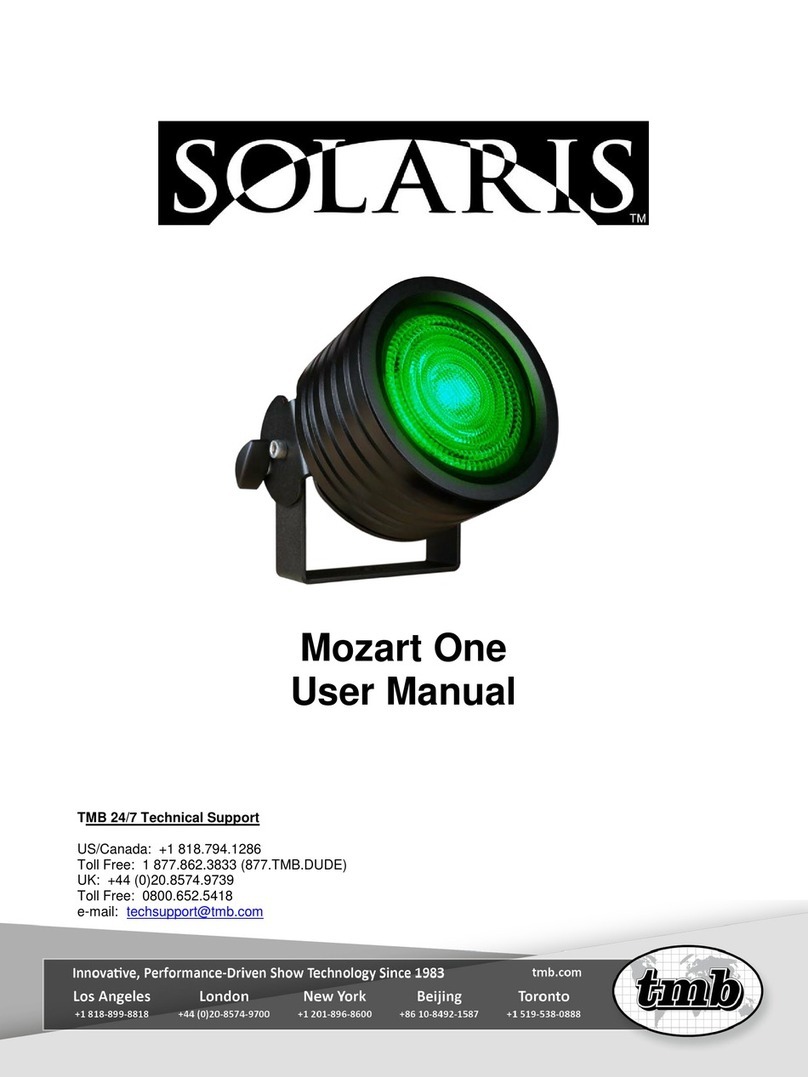
TMB
TMB Solaris Mozart One user manual

Dale Tiffany
Dale Tiffany TT12145 Assembly instructions
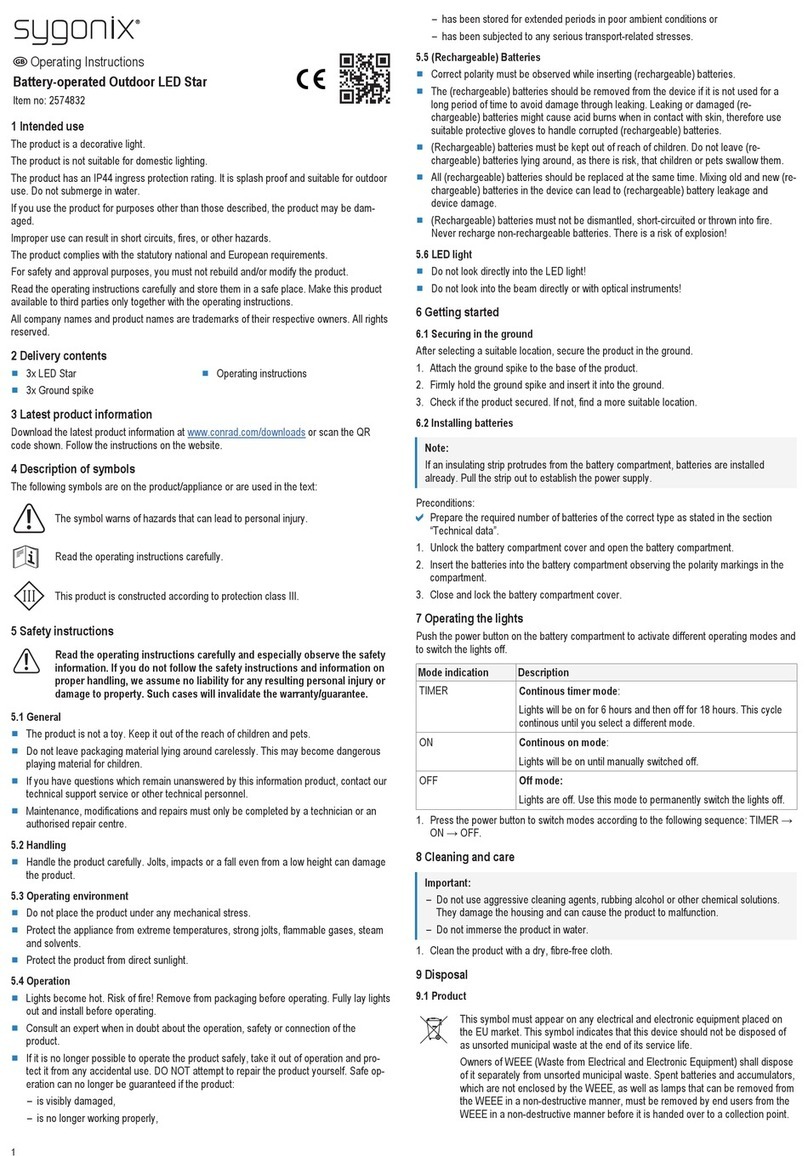
Sygonix
Sygonix 2574832 operating instructions

TopLite International
TopLite International Merlin-C Operation manual, maintenance & troubleshooting
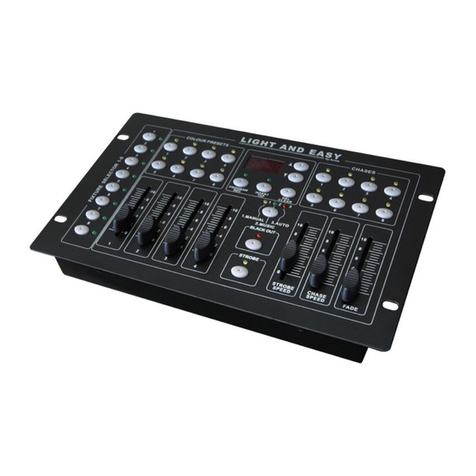
ACME
ACME LED-0408 user guide
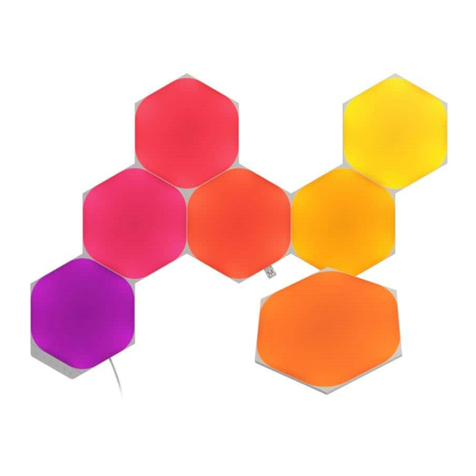
Nanoleaf
Nanoleaf Shapes Hexagons quick start guide
